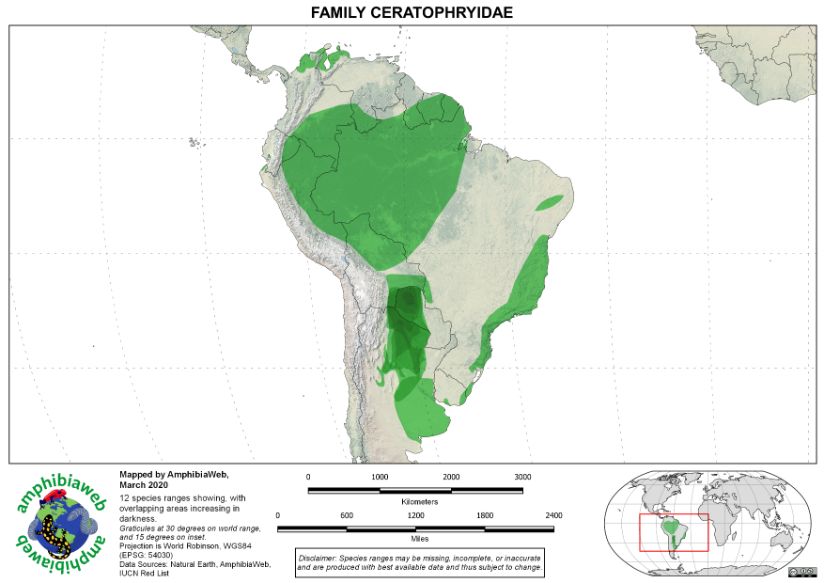Ceratophryidae |
12 species in 3 genera
Commonly Called Horned Frogs, Water Frogs
Ceratophrys cornuta
Photo by Jasper van Dalen
(Click for family gallery)The family Ceratophryidae includes the genus Ceratophrys, also known as Horned Frogs, which have huge heads with enormous gapes. Not all ceratophryids have "horned" appearance but they do have large mouths. These species are sit-and-wait predators that often mimic dried leaves. In general, they are highly carnivorous with as much as 50% of their prey volume consisting of vertebrates (frogs, lizards, snakes, and small rodents).
Formerly part of Leptodacylidae, this group was split out into a smaller family Ceratophryidae that also included the species currently in Batrachylidae and Telmatobiidae (they were subfamilies of Ceratophryidae). Subsequent studies confirm these were independent groups that were elevated to their present family levels.
Based on phylogenetic studies (Evans et al. 2008; Ruane et al. 2011), Blackburn and Wake (2011) include three extinct genera: Baurubatrachus, Beelzebufo, and Wawelia.
Written by AmphibiaWebNotable Family Characteristics
- Fossorial
- Inhabits lowland forests or semiarid regions
- Mostly nocturnal
- Highly carnivorous diet with as much as 50% of their prey volume consisting of vertebrates (frogs, lizards, snakes, and small rodents)
- Large heads and mouths; some species have characteristic 'horns' above each eye
- Distribution limited to South America

Cartography Credit: Zoe Yoo, UC Berkeley
Range maps sources: AmphibiaWeb, UC Berkeley, and IUCN RedListRelevant Reference
Blackburn, D.C. and Wake, D.B. 2011. Class Amphibia Gray, 1825. In: Zhang, Z.-Q. (Ed.) Animal biodiversity: An outline of higher-level classification and survey of taxonomic richness. Zootaxa. 3148: 39–55
Evans, S.E., Jones, M.E.H. & Krause, D.W. 2008. A giant frog with South American affinities from the Late Cretaceous of Madagascar. Proceedings of the National Academy of Sciences USA, 105, 2951–2956.
Faivovich, J., L. Nicoli, B. L. Blotto, M. O. Pereyra, D. Baldo, J. S. Barrionuevo, M. Fabrezi, E. R. Wild, and C. F. B. Haddad. 2014. Big, bad, and beautiful: phylogenetic relationships of the Horned Frogs (Anura: Ceratophryidae). South American Journal of Herpetology 9: 207–227.
Pough, F. H., R. M. Andrews, M. L. Crump, A. H. Savitzky, K. D. Wells, and M. C. Brandley. 2015. Herpetology. Fourth Edition. Massachusetts: Sinauer.
Ruane, S., Pyron, R.A. & Burbrink, F.T. 2011. Phylogenetic relationships of the Cretaceous frog Beelzebufo from Madagascar and the placement of fossil constraints based on temporal and phylogenetic evidence. Journal of Evolutionary Biology, 24, 274–285.
Vitt, L. J., and J. P. Caldwell. 2013. Herpetology. An Introductory Biology of Amphibians and Reptiles. Fourth Edition. Amsterdam: Elsevier.
Genus Ceratophrys (8 species)
Ceratophrys aurita no account photos no sound/video Ceratophrys calcarata account photos no sound/video Ceratophrys cornuta account photos sound/video Ceratophrys cranwelli account photos no sound/video Ceratophrys joazeirensis no account photos no sound/video Ceratophrys ornata account photos no sound/video Ceratophrys stolzmanni no account photos no sound/video Ceratophrys testudo no account no photos no sound/video
Genus Chacophrys (1 species)
Chacophrys pierottii account photos no sound/video
Genus Lepidobatrachus (3 species)
Lepidobatrachus asper no account photos no sound/video Lepidobatrachus laevis account photos no sound/video Lepidobatrachus llanensis no account photos no sound/video
Citation: AmphibiaWeb: Information on amphibian biology and conservation. [web application]. Berkeley, California: AmphibiaWeb. Available: https://amphibiaweb.org/. (Accessed:
AmphibiaWeb's policy on data use.

